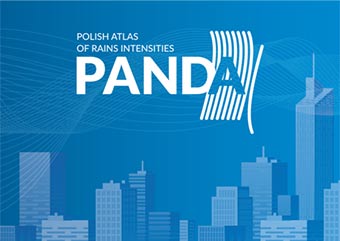The PANDA project represents the first up-to-date rainfall mapping system for urban areas in Poland, due to collaboration between rainwater and snowmelt management company Retencjapl, and the Polish Institute of Meteorology and Water Management – National Research Institute.
- 08 January 2020
As part of the Atlas PANDA project, local PANDA rain models have been sold to 20 locations in Poland. Agreements were reached to sell them in 30 other cities. In addition, we implemented projects with several companies that produce elements of drainage systems, to develop calculators for the selection of, for example, rainwater drainage systems using PANDA rain models.
The Polish Atlas of Rains Intensities (PANDA) project is the first online, digital and comprehensive rainfall mapping system in Poland. It is designed to help develop urban stormwater and drainage systems that better protect Polish towns, cities and their residents against the effects of heavy rainfall.
Historical data for future use
The system relies on historical, objective precipitation data from the past 30 years, recorded by 100 rain gauges managed by the Polish Institute of Meteorology and Water Management. The measuring stations are positioned strategically across the country, covering 940 Polish towns and cities. These stations have a monitoring capacity of up to 4 320 minutes of precipitation time, making them a useful tool for local governments and emergency services, and for companies in the water supply, design, architecture and transport industries.
Based on the three decades of data, the project developed an online rainfall intensity calculator, making it easier to assess potential threats in any area of the country. The data is accessible through a personal PANDA account, which any interested party can open online. The data allows local governments and companies to plan preventive actions and better equip infrastructure works and buildings against heavy rainfall or flooding. So far, the tool has been used by urban planners, building architects, engineers and – most importantly – waste and sewage management companies.
Adjusting to present-day meteorology conditions
The project answers the need for historical precipitation data for the design of modern rainwater and sewage management systems. This information is crucial whenever rainwater has to be managed on a city-wide scale, or for the design of extensive drainage networks. By continuing to collect data, authorities will be able to more precisely forecast floods and risk areas and take preventive actions.
Climate change is affecting cities worldwide, and Poland is no exception. An increasing number of heavy rains throughout the country have resulted in higher local flooding risk. Managing rainwater and drainage systems has to be adjusted to present-day meteorological conditions and based on accurate, up-to-date rainfall intensity models to ensure better preparedness when disaster strikes.
Total investment and EU funding
Total investment for the project “PANDA – Polish Atlas of Rains Intensities” is EUR 1 154 517, with the EU’s European Regional Development Fund contributing EUR 763 292 through the “OP Smart growth Poland” Operational Programme for the 2014-2020 programming period. The investment falls under the priority “Internal Market”.

